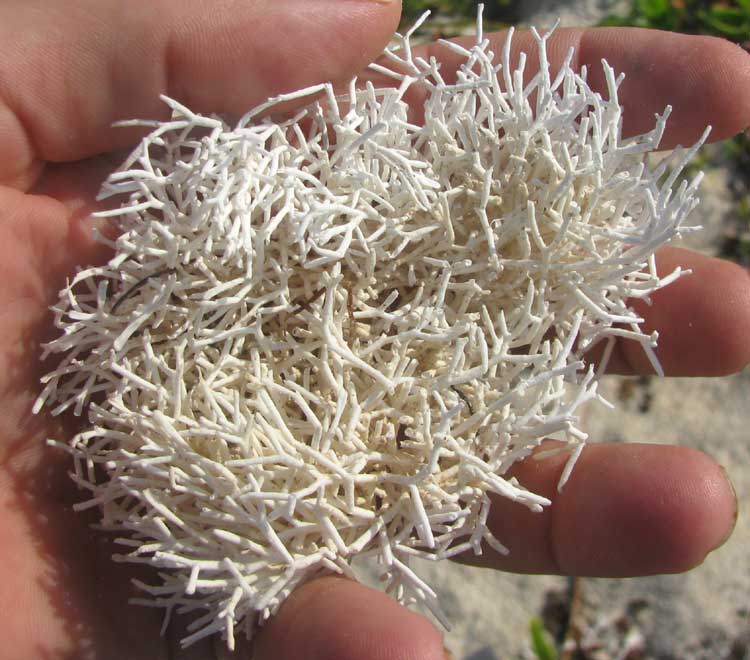Excerpts from Jim Conrad's
Naturalist Newsletter

from the June 26, 2011 Newsletter issued from Mayan Beach Garden Inn 20 kms north of Mahahual; Caribbean coastal beach and mangroves, ~N18.89°, ~W87.64°, Quintana Roo state, MÉXICO
CRUNCHY WHITE TUFTS OF... WHAT?
From one day to another you never know what you'll find on the beach. One day there's a knee-high pile of Turtlegrass, the next day that's all washed away and there are just a few shells. A while back the beach was strewn with white items looking like tufts of what Northerners know as Reindeer-moss Lichen, as shown above. Like dry Reindeer-moss Lichen, these tufts were so brittle that with your hand you could crush them into powder. However, they were too pretty to crush. Notice how the stems form Y-shaped branches. Such branching is said to be "dichotomous."
But, what kind of being is this? A coral, a sponge -- plant, animal, alga?
It was a kind of aquatic, invertebrate animal known as Bryozoa. Bryozoan colonies may grow as large as a meter across (3.3ft) but the individual tiny animals covering the white "skeleton" are microscopic. The colonies come in various shapes and forms, depending on the species -- treelike, sheetlike or fanlike, for instance. A fanlike bryozoan we've met is the Sea Fan, one of whose "skeletons" we show at www.backyardnature.net/yucatan/sea-fan.jpg
The world of bryozoans is so huge and diverse that you might enjoy browsing Wikipedia's bryozoan page, found at https://en.wikipedia.org/wiki/Bryozoa.
Doing a Google image search for Caribbean bryozoans, it wasn't long until I had a name for my Reindeer-moss-like bryozoan. It's the White Tangled Bryozoan, BRACEBRIDGIA SUBSULCATA, found from the Gulf of Mexico south in the western Atlantic to Argentina. I read that at depths between 15 and 40 meters it lives on deep vertical walls and under slanted walls, and usually is associated with certain sponges and corals.
Who knows what tore our washed-up bryozoans off their walls? Maybe just currents, maybe a boat dragging an anchor.